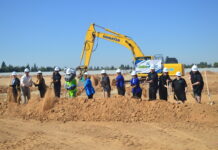
The following is quoted in full from Leon L. Loofbouros’s 1950 book, “In Search of God’s Gold.” It was published under the auspices of the Historical Society of the California-Nevada Annual Conference of the Methodist Church and in cooperation with the College of the Pacific, Stockton.
In 1985, Charles Winton Baley, a member of the pioneer family, extracted this article to capture additional history of Academy.
“Only six cities have sufficient ambition to maintain a full high school courses—San Francisco, Oakland, Sacramento, Stockton, Alameda, and Berkeley…Where are Los Angeles, San Diego, Pasadena, Riverside, Santa Barbara, San Luis Obispo, Fresno, Santa Rosa, San Jose, Marysville, and Grass Valley?” asked President Davis of the University of California. That was in the year of our Lord, 1888. There was strong opposition to spending tax money for anything above the elementary schools.
Twenty-one miles northeast of Fresno is a wide place in the old tollroad. It can scarcely be called a village—a combination filling station-post office-refreshment store, the Methodist Church, and a half dozen houses. Yet it bears the distinguished name of Academy.
The old stage road north from Visalia did not go up the valley where our rails and highways run—that was desert in summer and sometimes flooded in winter. It wound in and out through the foothills. The first center of government of Fresno County was Millerton, on the San Joaquin River. Oddly enough, it never had a church building. The home base of Millerton Circuit of the Methodist Episcopal Church South was in the Court House. (Fresno County was strongly Southern in early days. In the presidential election of 1856 only one vote was cast for the Republican candidate! This man achieved some fame as “the lone Republican of Fresno County.”)
On the Millerton Circuit, there was a preaching place at Big Dry Creek. The Simpsons, the Baleys, the Blasingames and others living here had ambitions for their community. Their school was doing well. They wanted it to be worthy of their children for generations to come.
In 1872, the Simpsons gave 10 acres, with others contributing from $250 to $750 in cash. They incorporated their educational plans for $50,000. So, in a fine grove of oaks, they built the best schoolhouse in the county. The veranda-surrounded building was proudly known as the academy. This soon became its official name, spelled with a capital “A”, and was then applied to the entire community. The school was also used for Methodist services when the circuit-riding preacher came from Millerton. As Academy’s fame grew, a parsonage was built, and the children of the parsonage swelled the school enrollment. Then a neat one room church was erected a little father up the road.
But times marched on—by another route. The railroad was built down in “the uninhabitable desert.” The county seat moved to Fresno, and churchless Millerton was abandoned. Academy people helped start the new county seat. Members from the Academy church aided in organizing St. Paul’s Methodist Church South, the first religious organization in Fresno. Then the Tollhouse road was straightened, and the once proud Academy was left alone among its ancient oaks. Now a bus takes the Academy youngest to Clovis, 10 miles away, for school. But the Methodist Church, the combination store and the half dozen houses perpetuate the name and memory of a day when their school as the pride of the county.
And when we read that the president of the state university said in 1888 that only six cities then maintained a full high school course, none of which was south of Stockton, we are grateful to the Simpsons, the Baleys and the Blasingames, who incorporated and built the Academy. And when we remember that this was only one of dozens founded by the Protestant churches in early days, we thank God for the courage and foresight of those early-day Christians. They saw the need for higher education long before the civic body did—and were willing to pay the bills.”
Our demand for educational excellence continues. It is a vital part of our rich heritage.








